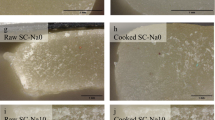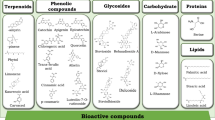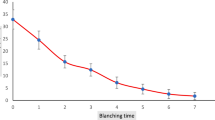Abstract
Aspartame was used in the manufacture of kalakand instead of sucrose. Sensory evaluation revealed that aspartame when used in the preparation of kalakand at a level of 0.065 % scored the highest in terms of sweetness perception and resembled control. Aspartame sweetened kalakand possessed the same desirable sweetness, colour, body and texture/consistency and mouthfeel even after 7 days of storage at 6–8 °C. Significant increase in titratable acidity of control as well as aspartame sweetened kalakand was observed during storage. However, only a slight drop in pH was observed in all samples on storage. The titratable acidity was higher in aspartame sweetened products than the corresponding control samples. Lightness (L*) was less in control samples with sucrose than the aspartame sweetened kalakand during storage. Total plate counts were higher in aspartame sweetened kalakand than its corresponding control throughout the storage period. Total plate counts increased linearly for both aspartame sweetened kalakand and control. A solid phase extraction method was standardized for the isolation of aspartame in kalakand. HPLC analytical conditions were standardized for separation of aspartame and its degradation products diketopiperazine and L-phenylalanine. HPLC analysis revealed that aspartame did not degrade in kalakand during storage establishing its stability in these products.




Similar content being viewed by others
Abbreviations
- UV:
-
Ultraviolet
- Kg:
-
Kilogram
- mL:
-
Mililitre
- ng:
-
Nanogram
- μL:
-
Microlitre
- ppm:
-
Parts per million
- cm:
-
Centimeter
- λmax :
-
Absorption maxima
- aw :
-
Water activity
- nm:
-
Nanometer
- SD:
-
Standard deviation
- LSD:
-
Least significant difference
References
Amerine MA, Pangborn RM, Roessler EB (1965) Principles of sensory valuation of food. Academic, New York
Arman, Temiz (1988) Stability of aspartame in tooth pastes. Acta PharmTurc 30:28–32
Bell LN, Labuza TP (1994) Aspartame stability in commercially sterilized flavoured dairy beverages. J Dairy Sci 77(1):34–38
BSEN:12856 (1999) Foodstuffs—Determination of acesulfame-K, aspartame and saccharin—High performance liquid chromatographic method. Cited by Wood R, Foster L, Key P (2004). In: Analytical methods for food additive, Woodhead Publshing Ltd., CRC Press, pp 231–252
Gothwal PP, Bhavdasan MK (1991) Studies on the browning characteristics in dairy products. Indian J Dairy Sci 45(3):146–151
IS:SP-18 (Part I) (1980) ISI Handbook for food analysis. Bureau of Indian Standards, Manak Bhavan, New Delhi
IS:SP-18 (Part XI) (1981) ISI handbook for food analysis-dairy products. Bureau of Indian Standards, Manak Bhavan, New Delhi
Kroger M, Meister K, Kava R (2006) Low-calorie sweeteners and other sugar substitutes: a review of the safety issues. Compr Rev Food Sci Food Saf 5:35–47
Lajtha A, Reilly MA, Danlop DS (1994) Aspartame consumption: lack of effects on neural function. J Nutr Biochem 5:226–283
Lawrence JF, Charbonneau CF (1988) Determination of seven artificial sweeteners in diet food preparations by reverse-phase liquid chromatography with absorbance detection. J Assoc Off Anal Chem 71(5):934–937
Mazur RH (1974) Aspartic acid-based sweeteners. In: Inglett GE (ed) ACS sweetener symposium. AVI Publishing, Westport
Meldrum BS (1993) Amino acids as dietary excitotoxins: a contribution to understanding neurodegenerative disorders. Brain Res 18:293–314
Prevention of food adulteration (1st amendment) rules (2004) Notification GSR No. 388(E). Prev Food Adulteration Cases 64(2):1–25
Snedcor GW, Cochran WG (1989) Statistical methods, 8th edn. Lowa University Press, Amsterdam
Suresh I, Jha YK (1994) Optimization of the process for kalakand manufacture and extension of its shelf life. J Food Sci Technol 31(5):389–394
Tschanz C, Butchko HH, Stargel WW, Kotsonis FN (eds) (1996) The clinical evaluation of a food additive: Assessment of aspartame. CRC Press, Boca Raton, p 308
Author information
Authors and Affiliations
Corresponding author
Rights and permissions
About this article
Cite this article
Gawande, H.M., Arora, S., Sharma, V. et al. Aspartame: safety and stability in kalakand . J Food Sci Technol 52, 2373–2379 (2015). https://doi.org/10.1007/s13197-013-1206-5
Revised:
Accepted:
Published:
Issue Date:
DOI: https://doi.org/10.1007/s13197-013-1206-5




